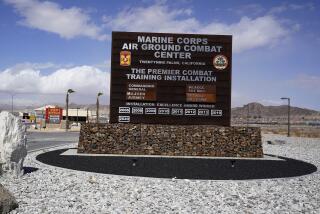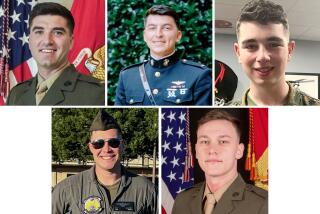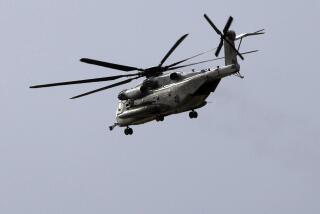What the Marine Saw
CAMP PENDLETON — When combat troops from the 15th Marine Expeditionary Unit arrived by helicopter in southern Afghanistan in the middle of the night to seize a former Taliban base, every U.S. Marine in the raiding force was packing a loaded M-16. One was also armed with a Nikon and a Sony video camera.
Sgt. Joseph Chenelly, 25, a combat correspondent, was there as a rifleman, but also to document the unit’s attempt to establish the first operating base in Afghanistan for conventional U.S. troops.
He was also there a few days later when heavily armed Marine “hunter-killer” teams moved cautiously toward the Taliban stronghold of Kandahar--unsure whether Afghan villagers would treat them as liberators or enemies.
And when Marines engaged in a fierce firefight in the pitch dark with Taliban and Al Qaeda fighters, Chenelly captured the action on video even as heat and light from exploding ordnance momentarily blinded his night vision lens.
With the rest of the 15th unit, Chenelly returned to Camp Pendleton last month, and now many of his pictures from 45 days on the front lines are on the Marine Corps Web site at www.usmc.mil/15meu.
The images provide an intimate look at the challenges of the Marine mission in Afghanistan: the blowing sand, Marine scouts digging in for combat, hungry Afghan children with bewildered faces, the American flag flying over war-torn Kandahar’s airport and more.
“It was a dream assignment,” says Chenelly, who studied journalism in college in his hometown of Rochester, N.Y., before enlisting in the Marine Corps.
It was also a uniquely Marine assignment.
Each of the military services has a job that involves taking pictures and writing accounts of troops in action, either for distribution within the military or to the media.
But the Marine Corps goes a significant step further, emphasizing that its combat correspondents are Marines first, correspondents second. A camera and notepad are important, a rifle and knife are mandatory. “I always stressed to my combat correspondents that they had to out-grunt the grunts,” said retired Col. Fred Peck. “When we’d go on a 25-mile hump [hike], none of my CCs would even think of dropping out. They’d die first.”
None of the unit’s Marines knew what awaited them at the Camp Rhino site as the CH-53E Super Stallion helicopters airlifted from the amphibious assault ship Peleliu in the Arabian Sea and other secret staging areas in Pakistan.
The date was Nov. 25, and the only U.S. troops “in country” at that point were scattered units of special forces working with Afghan opposition fighters and serving as spotters for the U.S. bombing campaign. The Marines were the first conventional U.S. troops involved. Although Army special forces had “cleared” the desert area around Rhino days earlier, the possibility remained of enemy snipers, land mines or other booby traps. After decades of war, Afghanistan is considered the most heavily land-mined country in the world.
“It was very disorienting to be there in the middle of the night with no landmarks for miles around,” Chenelly said. “And everything, everywhere was covered with dust. The first thing I worried about was my camera: Would it stay operational?”
The dust was a continual hazard during the Marines’ six-week stay at Rhino, making it difficult to land cargo planes, contributing to the crash of a Huey helicopter, jamming machinery and weaponry. Even training at the Marines’ base in the high desert of San Bernardino County had not prepared them for the grit of central Asia.
“In Twentynine Palms, it’s dirt,” Chenelly said. “This was dust. Dirt will blind you but dust will make it so you can’t breathe.”
Once Camp Rhino was established, Marines from the elite Force Reconnaissance moved northward to intercept Taliban and Al Qaeda forces fleeing a major battle north of Kandahar to regroup and possibly mount a counteroffensive.
In Humvees and light-armored vehicles, Marines moved slowly through villages in search of fleeing enemy troops. They disarmed anyone suspected of being Taliban or Al Qaeda fighters and, if they were not hostile, let them go. Villagers, mostly old men and children, greeted the Marines.
“We didn’t know whether they would attack us or be supportive or something in between,” Chenelly said. “It was a very tense several days, always keeping our eyes wide open.”
As helicopters on resupply missions swooped low, villagers would wave. When a Marine vehicle had trouble fording a stream, villagers made a rock bridge. To show their gratitude, Marines gave away food packages and called for an Air Force food drop.
To prevent enemy vehicles from fleeing Kandahar, the Marines were ordered on the night of Dec. 7 to set up a roadblock. Thirty feet of razor-sharp concertina wire was strung across a narrow asphalt road and anchored by tent pegs.
Glowing “chemlights” were attached to the wire so the roadblock could be seen by oncoming drivers. Marines positioned their vehicles at the bottom of a berm beside the road and snipers crouched several hundred yards away. Chenelly took up his video camera.
Shortly after 4 a.m., headlights were spotted rushing toward the roadblock. A truck hit the concertina wire and skidded to a stop. On the video, Marines can be heard calling to each other excitedly, “He blew it. He blew it.” Chenelly remembers the sound of the wire scraping the side of the truck. A Marine who speaks the local Afghan dialect shouted for the men in the truck to drop their weapons.
Instead, men in the cab and the truck bed--who appeared to be sleeping--raised their AK-47s at the Marines, some of whom were just 10 feet away. In an instant, both sides began firing--captured on video as green glowing tracer rounds. “Force Recon didn’t hesitate for a second,” Chenelly said. “They didn’t flinch. If they had, I don’t think we’d have all made it out alive.”
The heat of the rounds ignited an ammunition cache in the back of the truck. Rounds, including rocket-propelled grenades, shot off in all directions, like some deadly Fourth of July celebration.
“It’s very surreal when it’s happening,” said Chenelly. “For a second, you can’t believe it. It’s like an Arnold Schwarzenegger movie. It goes so fast and everything blows up.”
Seconds later, Marines can be heard on the video calling out, “Go, go, go, quick, quick, get back.” An authoritative voice--that of a master sergeant, the ranking Marine on the scene--barks out, “Let me know when everybody is in.”
The Marines withdrew down the road, leaving eight Taliban and Al Qaeda members dead, their truck a flaming ruin. The Marines left the bodies on the road as a warning to others who might decide to fight rather than surrender. None of the Marines were injured.
The inevitable question: Were you afraid?
“There was no time to be scared,” Chenelly said. “I was just confident with the Marines out there and confident that the command wouldn’t put us in a situation that we couldn’t handle.”
Quiet and deferential, Chenelly is set to leave active duty soon. He may go back to college or take a civilian job as a reporter or photographer. Asked about his best memory of Afghanistan, his answer is more Marine than correspondent. He remembers that night on Route 1 with Force Recon.
A helicopter arrived the day after the firefight to pick up Chenelly’s video so the film could be reviewed by military brass back at Camp Rhino, the Pentagon and the U.S. Central Command in Tampa, Fla.
After the firefight, and an aerial attack minutes later that destroyed other trucks in the enemy convoy, the Taliban and Al Qaeda never again tried to use the road. Afghan opposition forces won the battle at Kandahar, and the Taliban government toppled.
“Basically we took that route away from them,” Chenelly said. “That felt good.”
More to Read
Sign up for Essential California
The most important California stories and recommendations in your inbox every morning.
You may occasionally receive promotional content from the Los Angeles Times.










